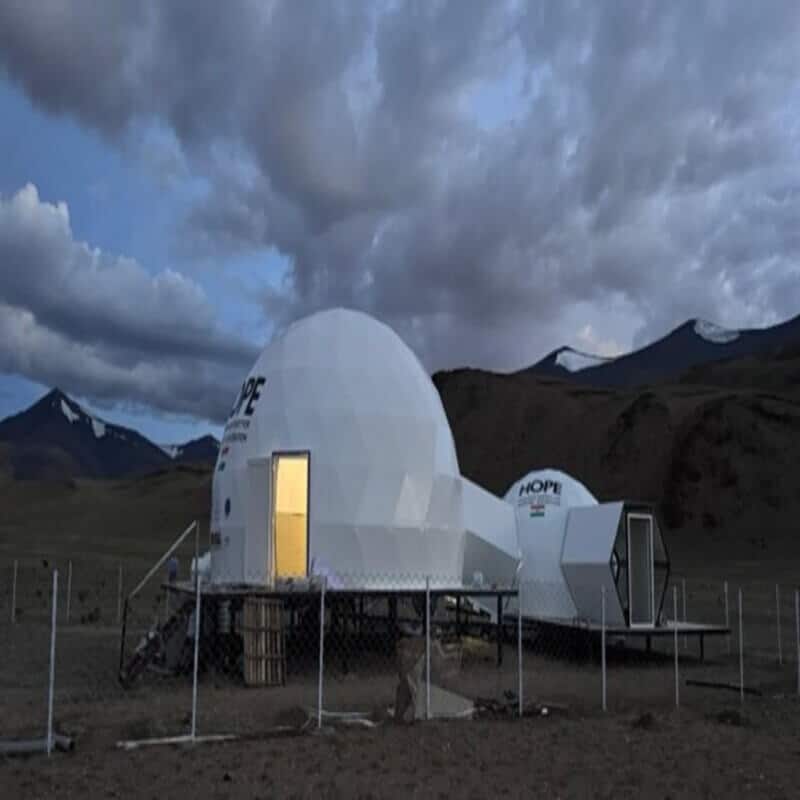
ISRO’s HOPE Analog Mission in Ladakh has begun research aiming to Simulate Space-like conditions on Earth. Tso Kar valley was specifically selected for this analog mission due to its striking environmental parallels with early Mars, due to high UV flux, low air pressure, cold extremes and saline permafrost. Read here to learn more.
In a significant step toward preparing for future interplanetary missions, the Indian Space Research Organisation (ISRO) has inaugurated the Himalayan Outpost for Planetary Exploration (HOPE) in Tso Kar Valley, Ladakh.
This analog mission station is a cutting-edge Earth-based facility designed to replicate the hostile conditions of the Moon and Mars, enabling comprehensive research and testing ahead of human spaceflight missions.
What is the HOPE Analog Mission?
HOPE is a specially designed setup comprising:
- A Dia 8 metre Habitat Module for human crew living, and
- A Dia 5 metre Utility Module for operations and technical support.
The two modules are interconnected to simulate a self-sufficient space environment for astronauts and to test workflow, protocols, and system interoperability under simulated extraterrestrial conditions.
Objectives of HOPE
- Simulate Lunar and Martian Environments: Test systems and crew behavior under low pressure, high radiation, and extreme cold
- Human Factors Research:
- Conduct studies in epigenetics, genomics, physiology, and psychology.
- Validate health monitoring systems and habitation protocols.
- Astrobiology and Microbial Analysis: Develop and refine sample collection and biological testing techniques.
- Operational Protocols for Planetary Surfaces: Test mobility, robotics, and extravehicular activities (EVAs) under real-like terrain and conditions.
- Support Gaganyaan and Beyond: Aid India’s Gaganyaan mission and prepare for future Moon and Mars crewed missions.
Why Tso Kar Valley, Ladakh?

Tso Kar Valley was strategically chosen for its extreme and Mars-like environment:
- High UV radiation
- Low atmospheric pressure
- Saline permafrost
- Extreme temperatures and high-altitude terrain
These natural features make the location ideal to simulate Martian surface conditions, supporting both technological testing and astrobiological research.
HOPE Analog mission: Global significance
ISRO’s HOPE joins a growing list of analog research missions globally, such as:
- Mars Desert Research Station (USA)
- Flashline Mars Arctic Research Station (Canada)
- BIOS-3 (Russia)
These stations play a vital role in:
- Testing life support and equipment,
- Studying long-duration isolation effects,
- Developing remote communication and autonomous survival protocols.
HOPE marks India’s entry into this elite club, signalling its readiness for planetary habitation research and deep space exploration.
Global analog missions: Comparison
Parameter |
HOPE (India) |
Mars Desert Research Station (USA) |
Flashline Mars Arctic Research Station (Canada) |
BIOS-3 (Russia) |
Country |
India |
United States |
Canada |
Russia |
Agency / Organisation |
ISRO (Human Space Flight Centre) |
Mars Society |
Mars Society / NASA collaboration |
Institute of Biophysics, Russian Academy |
Location |
Tso Kar Valley, Ladakh |
Utah Desert |
Devon Island, Canadian Arctic |
Krasnoyarsk, Siberia |
Environment Simulated |
Moon and Mars-like conditions (high-altitude, permafrost, radiation) |
Martian terrain and isolation |
Mars-like extreme cold, isolation, and remoteness |
Closed ecological systems (biosphere) |
Main Focus Areas |
Human health, habitability, life-support validation, astrobiology |
Crew behavior, isolation, EVA drills |
Long-duration habitation, engineering & robotics |
Closed-loop life support and food production |
Crewed Missions |
short-term analog astronauts |
2–4 weeks per mission |
limited and seasonal |
fully enclosed for months |
Notable Features |
First Indian analog station; high UV, low pressure |
Highly active with international crews |
Among the most remote analog bases in the world |
Historical precursor to Biosphere 2 |
Research Types |
Genomics, physiology, psychology, planetary sampling |
Team psychology, habitat logistics |
Habitat construction, mission stress, AI robotics |
Bioregenerative life support |
Unique Advantage |
Mars-like topography + high-altitude Indian terrain |
Accessibility and low-cost operations |
Harsh Arctic isolation mimics Martian remoteness |
Longest closed ecosystem experiments |
Collaboration and Leadership
The HOPE mission is led by:
- ISRO’s Human Space Flight Centre (HSFC)
In collaboration with:
- Top Indian research institutions (IISc, AIIMS, DRDO labs)
- Industry partners for module construction and life support integration
This reflects a multi-stakeholder approach combining space science, human health, engineering, and environmental research.
Significance for India
- Strategic Leap in Human Spaceflight: HOPE will directly contribute to the Gaganyaan mission and future planetary exploration goals.
- Promotes Indigenous R&D: Enhances India’s capability in developing indigenous life-support systems, AI-driven monitoring, and modular habitat design.
- Boosts Ladakh’s Strategic Value: The project reinforces Ladakh’s role not just in defence but also in cutting-edge scientific infrastructure.
- Global Leadership in Space Medicine and Astrobiology: Places India on the frontier of astrobiological exploration and crew health research, vital for missions to Moon, Mars, and beyond.
Conclusion
ISRO’s HOPE analog mission is not just a simulation experiment, it is a visionary leap into the future of Indian space exploration.
The valuable data generated through these Analog Missions organized by HSFC will form the basis for design of protocols and infrastructure for future Indian Human Exploration Missions by providing key insights into technology performance, crew workflows, and environmental adaptation.
By replicating space-like conditions in one of Earth’s harshest terrains, HOPE will lay the groundwork for India’s role in sustainable and long-term human presence beyond Earth.
It aligns with ISRO’s ambitions of transitioning from being a cost-effective satellite launcher to becoming a leader in interplanetary human missions.
Related articles:







Leave a Reply